Building of Longitudinal Ultrasonic Assisted Turning System and Its Cutting Simulation Study on Bulk Metallic Glass
Abstract
1. Introduction
2. Building of Longitudinal Ultrasonic Assisted Turning System
2.1. Design of the Piezoelectric Transducer and the Ladder Horn
2.2. Modal and Harmonic Analysis of the LUAT System
2.3. Vibration Testing Experiment of the LUAT System
3. Turning Simulation of Vit1 Bulk Metallic Glass
3.1. Finite Element Modeling of Vit1 BMG Turning Simulation
3.2. Analysis of LUAT Process
- When is much larger than , the direction of the closing speed remains unchanged, and the size is first equal to , which can be regarded as CT;
- When is slightly larger than , the tool tip keeps contact with the workpiece, the direction of closing speed remains unchanged and the size changes periodically;
- When is smaller than the maximum value of , the direction of closing speed changes periodically, and the contact separation state of tool tip and workpiece presents high frequency. At this time, the relationship between the tool and the workpiece is changed from the original tool extruding the workpiece to the high frequency tool hitting the workpiece.
4. Results and Discussion
4.1. Analysis of Average Cutting Force
4.2. Analysis of Instantaneous Cutting Force
4.3. Internal Stress Analysis of Workpiece
5. Conclusions
- Simulation and theoretical analysis show that there is a critical turning speed in LUAT, which is determined by the longitudinal ultrasonic device. When the turning speed is lower than the critical turning speed, the longitudinal ultrasonic vibration can effectively reduce the average cutting force and von Mises stress of BMG cutting processing;
- When the longitudinal ultrasonic vibration is applied in low speed turning, the tool and workpiece will have contact-separation phenomenon, which is conducive to the reduction of average cutting force and the periodic formation of chips;
- During the turning process of BMG, the application of longitudinal ultrasonic vibration is rewarding to the formation of chips, so that the periodicity of instantaneous turning force is more obvious, which can help to form more regular chips and machined surface morphology;
- LUAT can remarkably decrease the von Mises stress in both chips and machined surface, especially in the first deformation zone. This reduction is beneficial to improve the turning process of BMG.
Author Contributions
Funding
Conflicts of Interest
References
- Wang, W.H. The elastic properties, elastic models and elastic perspectives of metallic glasses. Prog. Mater. Sci. 2012, 57, 487–656. [Google Scholar] [CrossRef]
- Zhu, P.-Z.; Qiu, C.; Fang, F.-Z.; Yuan, D.-D.; Shen, X.-C. Molecular dynamics simulations of nanometric cutting mechanisms of amorphous alloy. Appl. Surf. Sci. 2014, 317, 432–442. [Google Scholar] [CrossRef]
- Hofmann, D.C. Bulk metallic glasses and their composites: A brief history of diverging fields. J. Mater. 2013, 2013, 517904. [Google Scholar] [CrossRef]
- Chen, M.W. A brief overview of bulk metallic glasses. NPG Asia Mater. 2011, 3, 82–90. [Google Scholar] [CrossRef]
- Liens, A.; Etiemble, A.; Rivory, P.; Balvay, S.; Pelletier, J.M.; Cardinal, S.; Fabregue, D.; Kato, H.; Steyer, P.; Munhoz, T.; et al. On the Potential of Bulk Metallic Glasses for Dental Implantology: Case Study on Ti40Zr10Cu36Pd14. Materials 2018, 11, 249. [Google Scholar] [CrossRef] [PubMed]
- Basak, A.K.; Zhang, L.C. Deformation of Ti-Based Bulk Metallic Glass Under a Cutting Tip. Tribol. Lett. 2018, 66, 27. [Google Scholar] [CrossRef]
- Browne, D.J.; Stratton, D.; Gilchrist, M.D.; Byrne, C.J. Bulk Metallic Glass Multiscale Tooling for Molding of Polymers with Micro to Nano Features: A Review. Metall. Mater. Trans. A Phys. Metall. Mater. Sci. 2013, 44, 2021–2030. [Google Scholar] [CrossRef]
- Zhao, Y.; Lu, J.; Zhang, Y.; Wu, F.; Huo, D. Development of an analytical model based on Mohr–Coulomb criterion for cutting of metallic glasses. Int. J. Mech. Sci. 2016, 106, 168–175. [Google Scholar] [CrossRef]
- Karaguzel, U.; Bakkal, M. Orthogonal cutting of Zr based bulk metallic glass by radial turning. In Proceedings of the International Conference On Materials Science, Metal and Manufacturing, Singapore, 12–13 December 2011. [Google Scholar]
- Fujita, K.; Morishita, Y.; Nishiyama, N.; Kimura, H.; Inoue, A. Cutting Characteristics of Bulk Metallic Glass. Mater. Trans. 2005, 46, 2856–2863. [Google Scholar] [CrossRef]
- Bakkal, M.; Liu, C.T.; Watkins, T.R.; Scattergood, R.O.; Shih, A.J. Oxidation and crystallization of Zr-based bulk metallic glass due to machining. Intermetallics 2004, 12, 195–204. [Google Scholar] [CrossRef]
- Bakkal, M.; Shih, A.J.; McSpadden, S.B.; Liu, C.T.; Scattergood, R.O. Light emission, chip morphology, and burr formation in drilling the bulk metallic glass. Int. J. Mach. Tools Manuf. 2005, 45, 741–752. [Google Scholar] [CrossRef]
- Bakkal, M.; Shih, A.J.; Scattergood, R.O.; Liu, C.T. Machining of a Zr–Ti–Al–Cu–Ni metallic glass. Scr. Mater. 2004, 50, 583–588. [Google Scholar] [CrossRef]
- Bakkal, M.; Shih, A.J.; Scattergood, R.O. Chip formation, cutting forces, and tool wear in turning of Zr-based bulk metallic glass. Int. J. Mach. Tools Manuf. 2004, 44, 915–925. [Google Scholar] [CrossRef]
- Liu, C.T.; Heatherly, L.; Easton, D.S.; Carmichael, C.A.; Schneibel, J.H.; Chen, C.H.; Wright, J.L.; Yoo, M.H.; Horton, J.A.; Inoue, A. Test environments and mechanical properties of Zr-base bulk amorphous alloys. Metall. Mater. Trans. A Phys. Metall. Mater. Sci. 1998, 29, 1811–1820. [Google Scholar] [CrossRef]
- Lauwers, B.; Bleicher, F.; Ten Haaf, P.; Vanparys, M.; Bernreiter, J.; Jacobs, T.; Loenders, J.; Leuven, K. Investigation of the Process-Material Interaction in Ultrasonic Assisted Grinding of ZrO2 based Ceramic Materials. In Proceedings of the 4th CIRP International Conference on High Performance Cutting, Gifu, Japan, 24–26 October 2010. [Google Scholar]
- Pujana, J.; Rivero, A.; Celaya, A.; de Lacalle, L.N.L. Analysis of ultrasonic-assisted drilling of Ti6Al4V. Int. J. Mach. Tools Manuf. 2009, 49, 500–508. [Google Scholar] [CrossRef]
- Sui, H.; Zhang, X.Y.; Zhang, D.Y.; Jiang, X.G.; Wu, R.B.A. Feasibility study of high-speed ultrasonic vibration cutting titanium alloy. J. Mater. Process. Technol. 2017, 247, 111–120. [Google Scholar] [CrossRef]
- Maurotto, A.; Muhammad, R.; Roy, A.; Silberschmidt, V. Enhanced ultrasonically assisted turning of a β-titanium alloy. Ultrasonics 2013, 53, 1242–1250. [Google Scholar] [CrossRef]
- Nath, C.; Rahman, M.; Neo, K.S. A study on the effect of tool nose radius in ultrasonic elliptical vibration cutting of tungsten carbide. J. Mater. Process. Technol. 2009, 209, 5830–5836. [Google Scholar] [CrossRef]
- Luo, F.; Sun, F.; Li, K.S.; Gong, F.; Liang, X.; Wu, X.Y.; Ma, J. Ultrasonic assisted micro-shear punching of amorphous alloy. Mater. Res. Lett. 2018, 6, 545–551. [Google Scholar] [CrossRef]
- Ma, J.; Liang, X.; Wu, X.; Liu, Z.; Gong, F. Sub-second thermoplastic forming of bulk metallic glasses by ultrasonic beating. Sci. Rep. 2015, 5, 17844. [Google Scholar] [CrossRef]
- Schuh, C.A.; Lund, A.C. Atomistic basis for the plastic yield criterion of metallic glass. Nat. Mater. 2003, 2, 449–452. [Google Scholar] [CrossRef] [PubMed]
- Lu, J.; Ravichandran, G.; Johnson, W.L. Deformation behavior of the Zr41.2Ti13.8CU12.5Ni10Be22.5 bulk metallic glass over a wide range of strain-rates and temperatures. Acta Mater. 2003, 51, 3429–3443. [Google Scholar] [CrossRef]
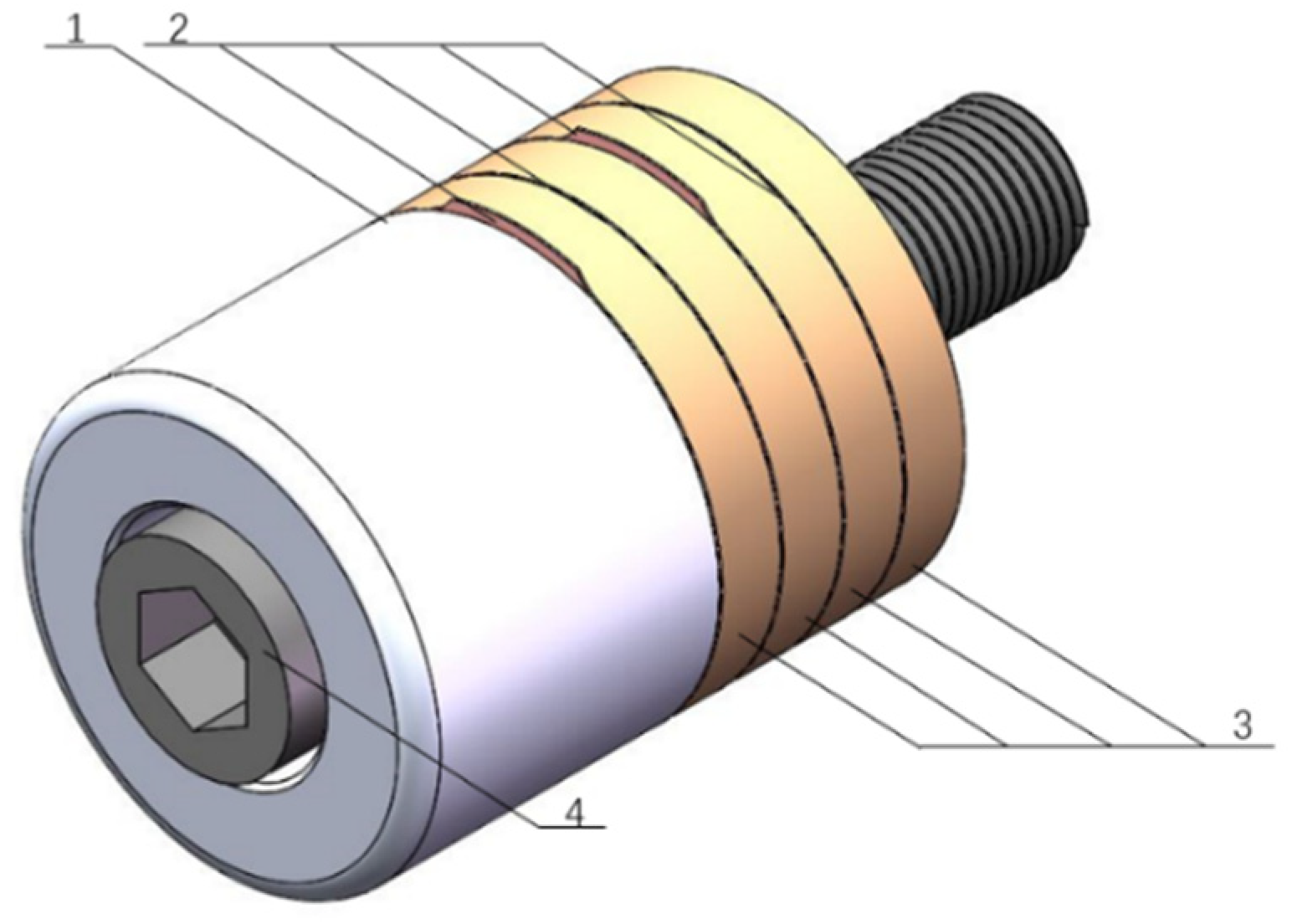
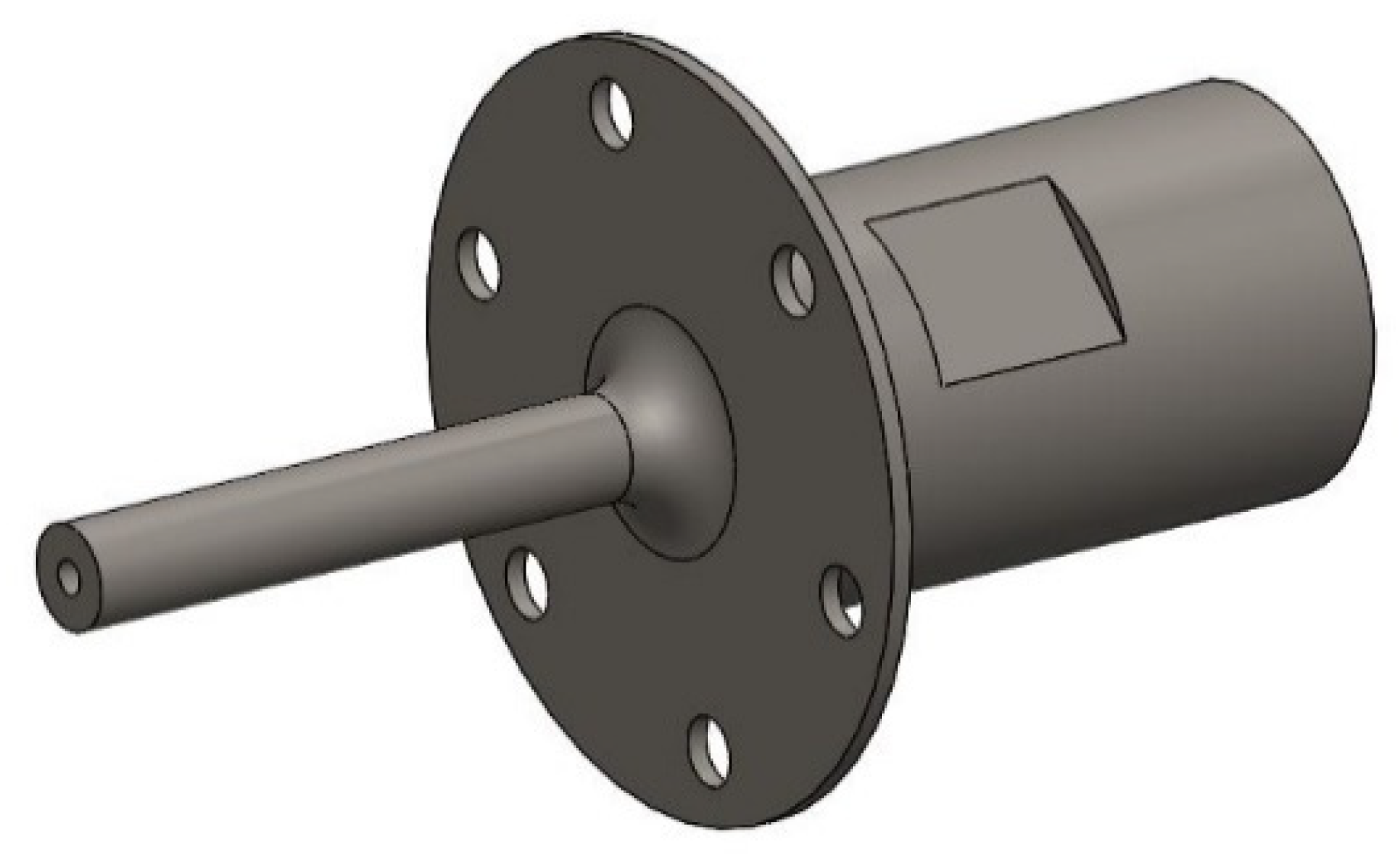
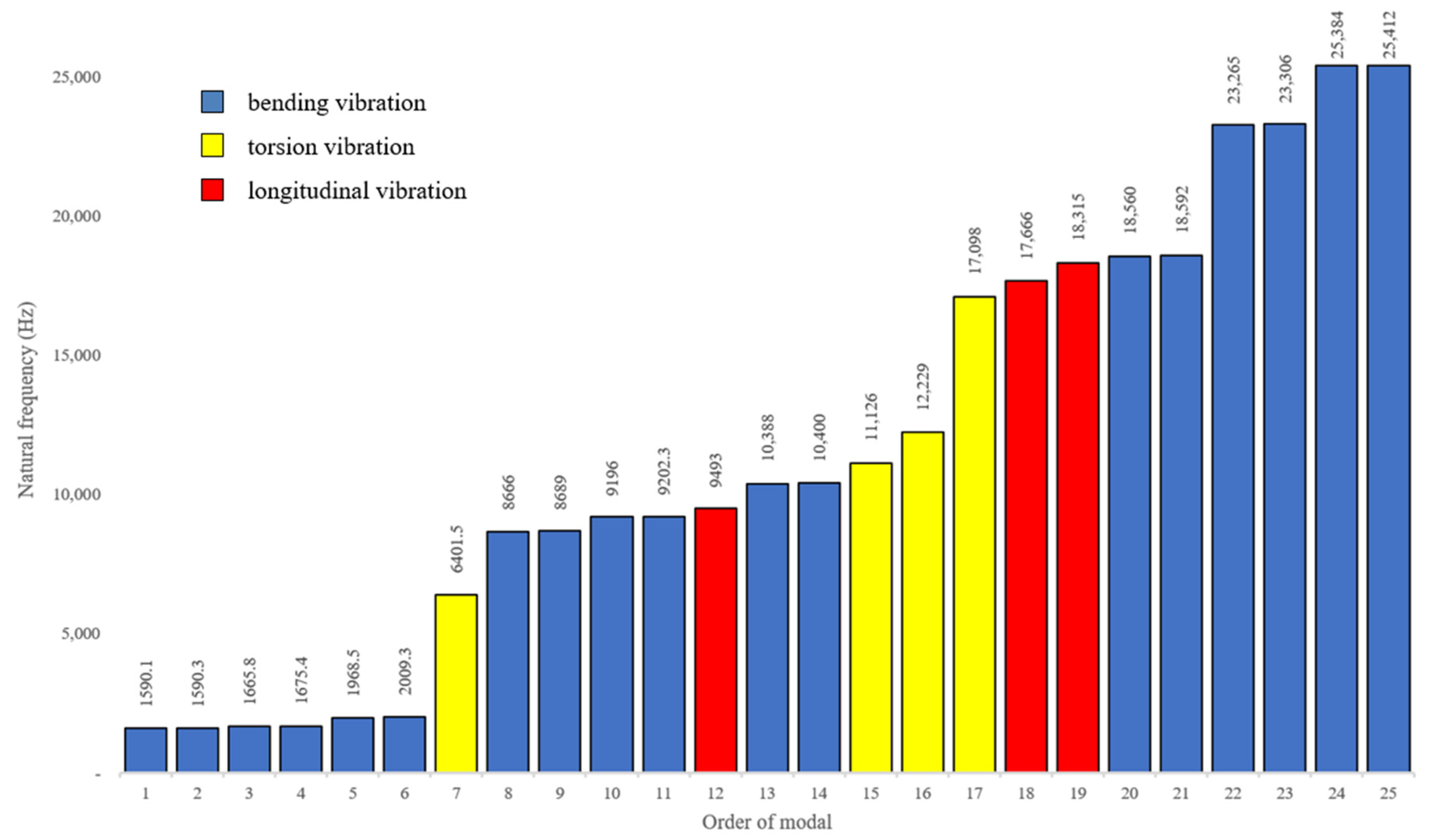

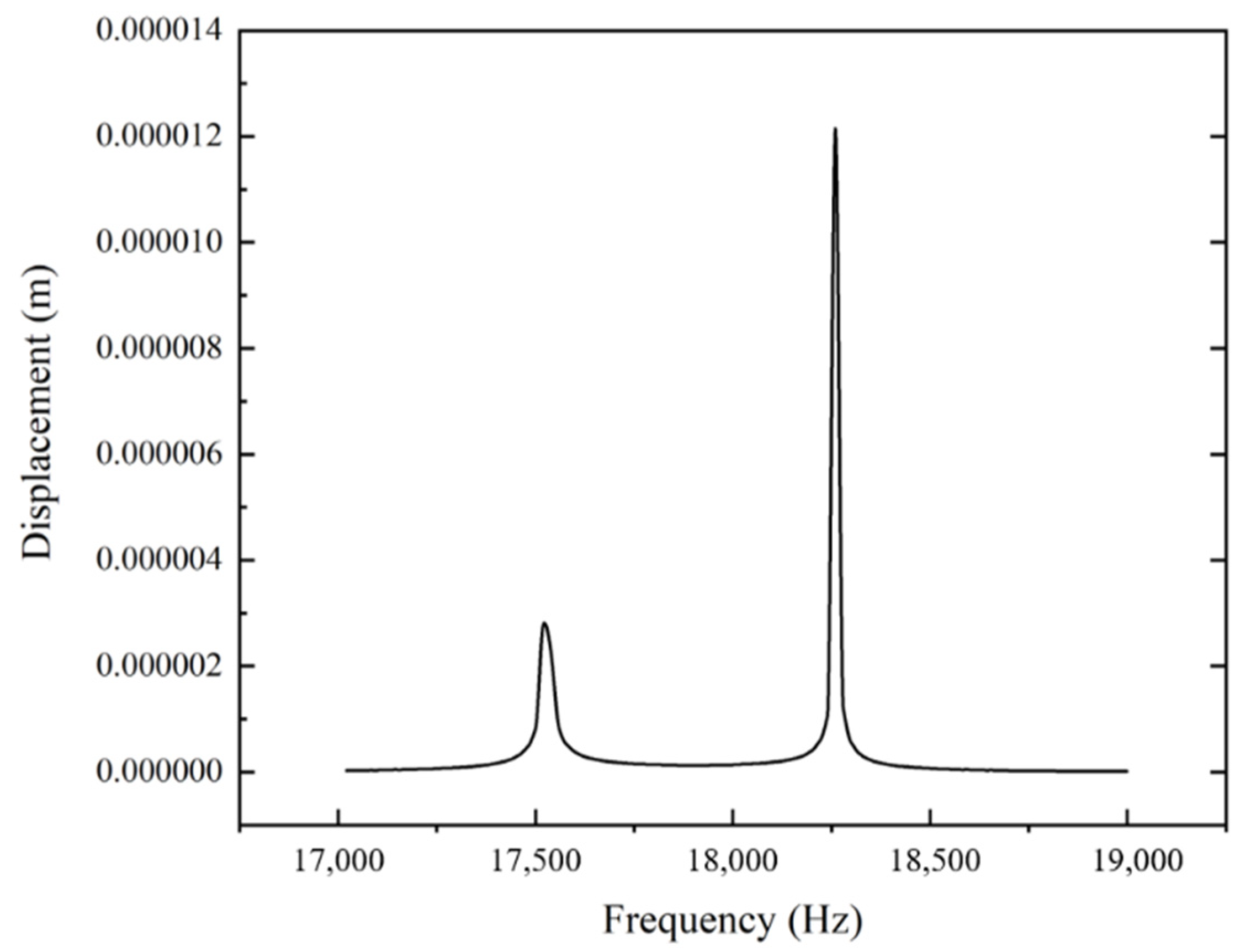
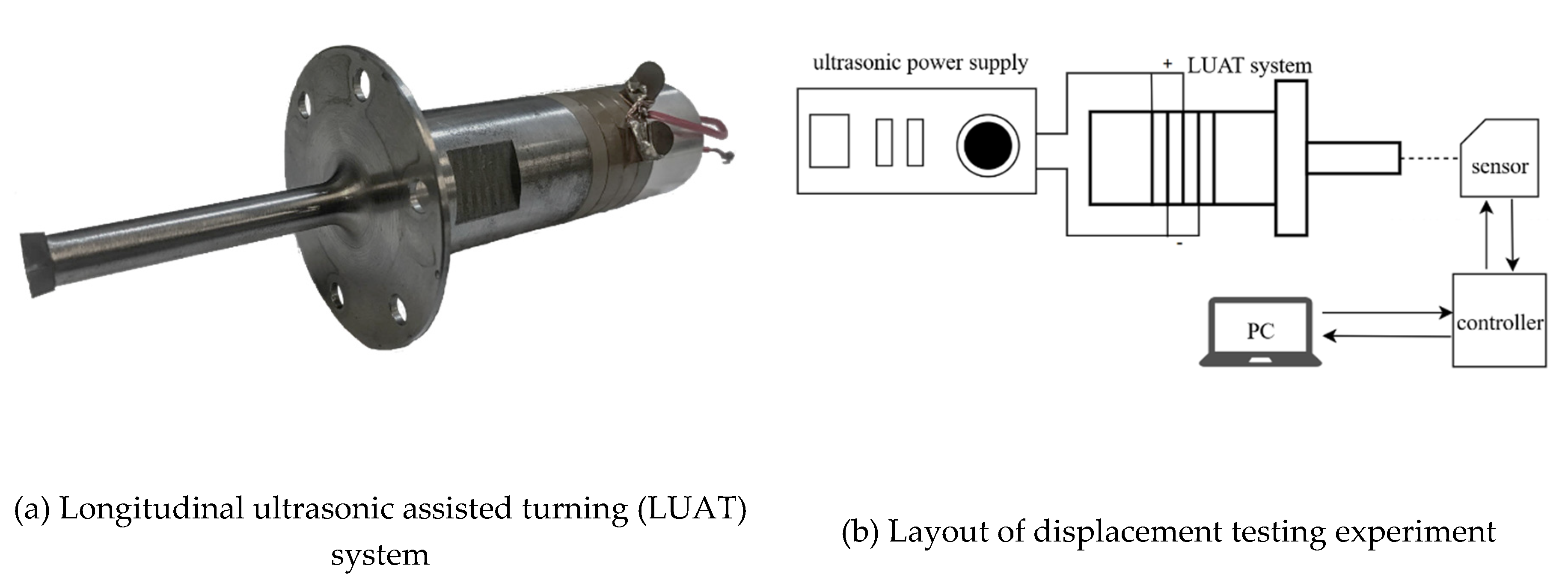
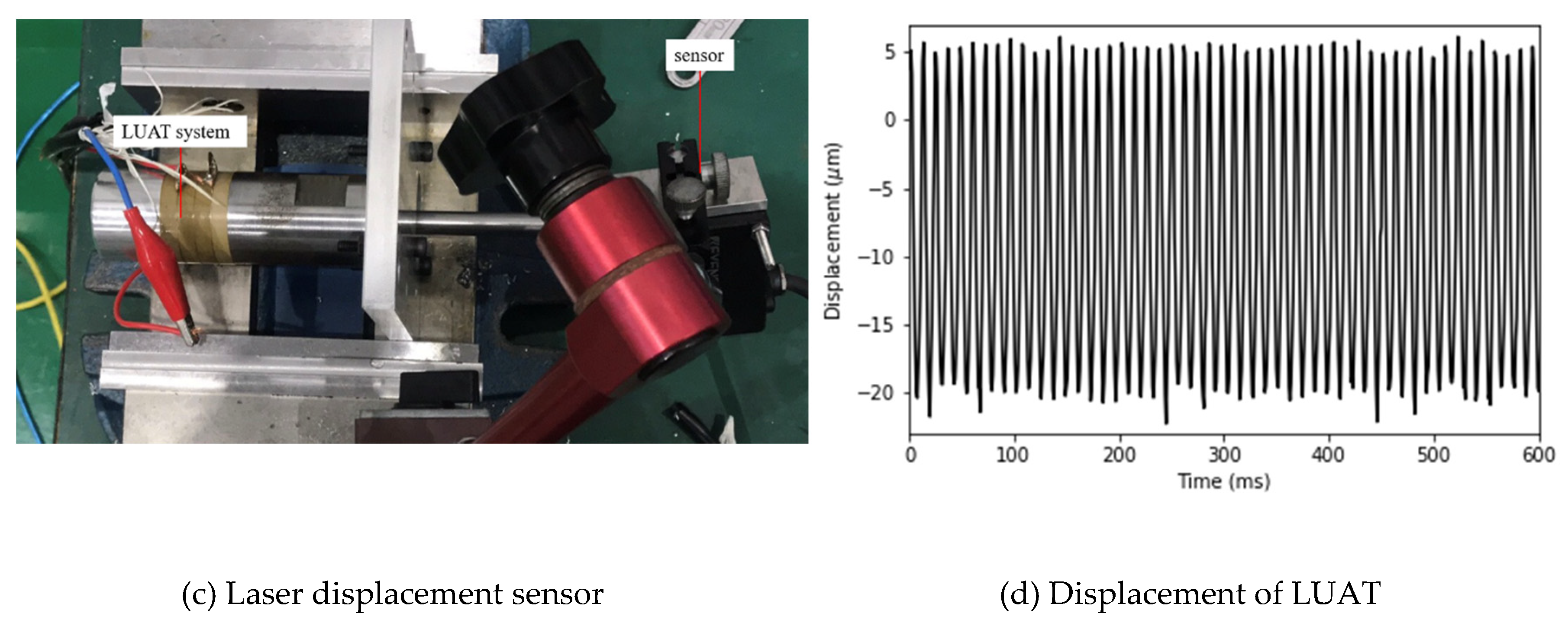
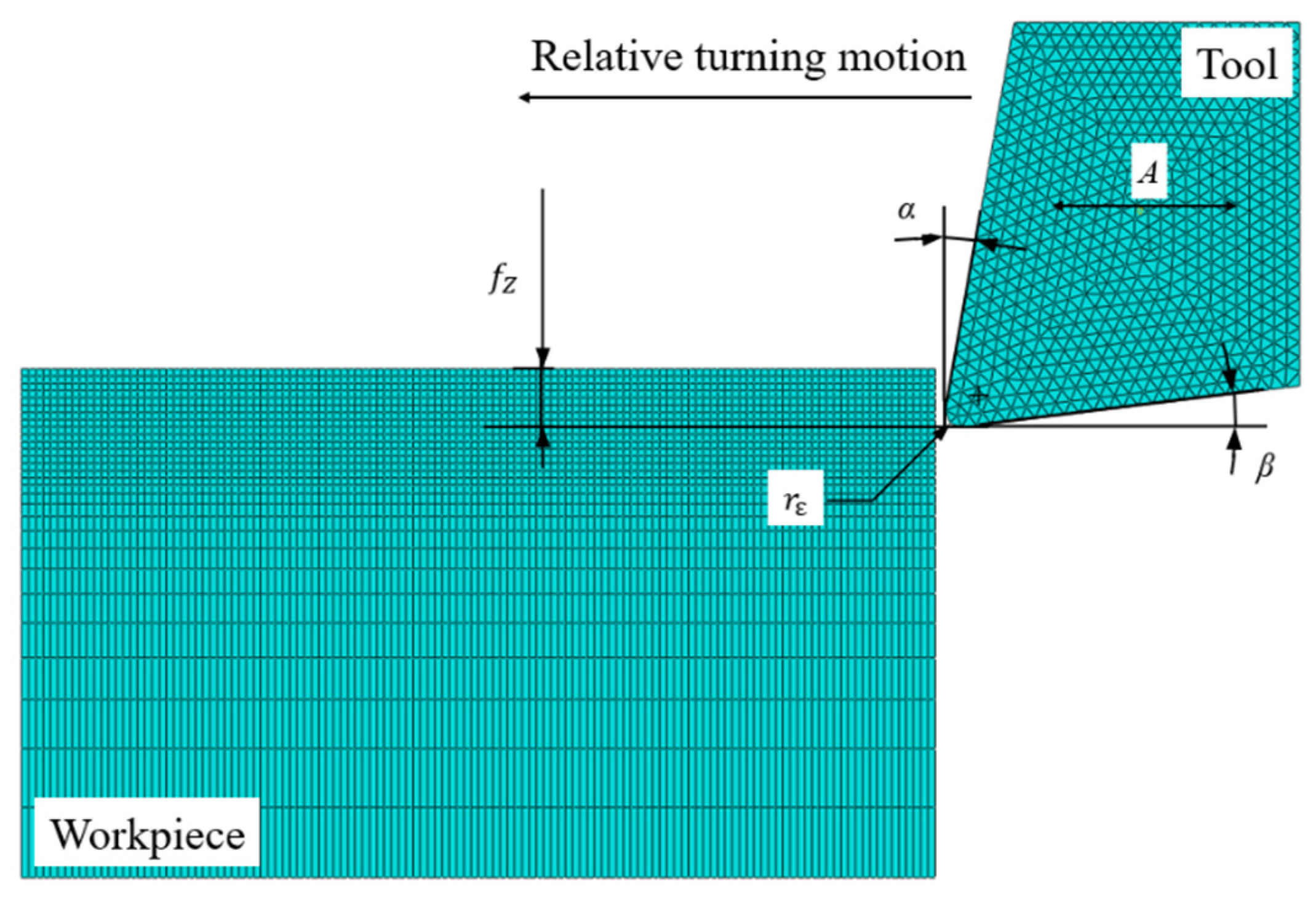
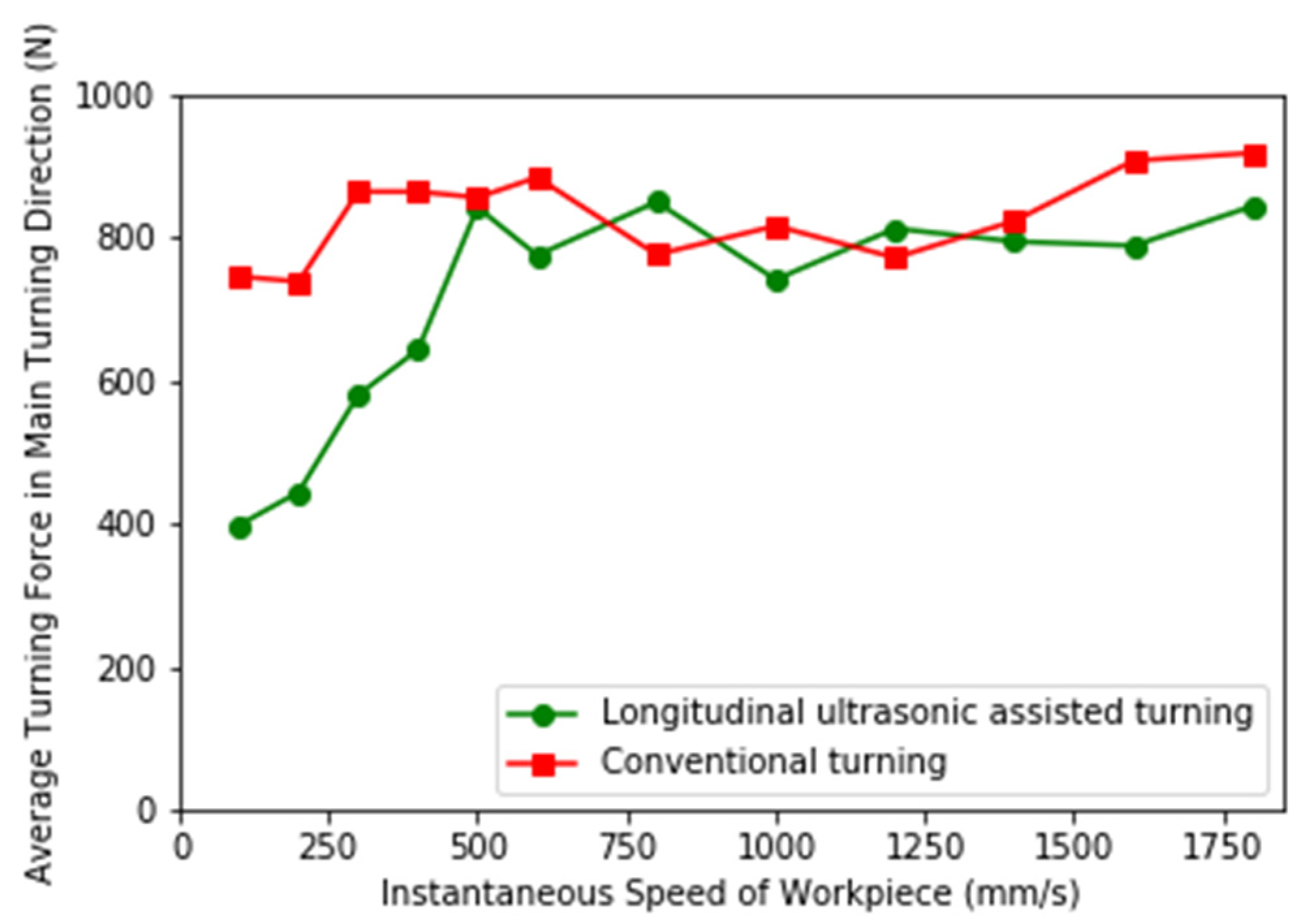
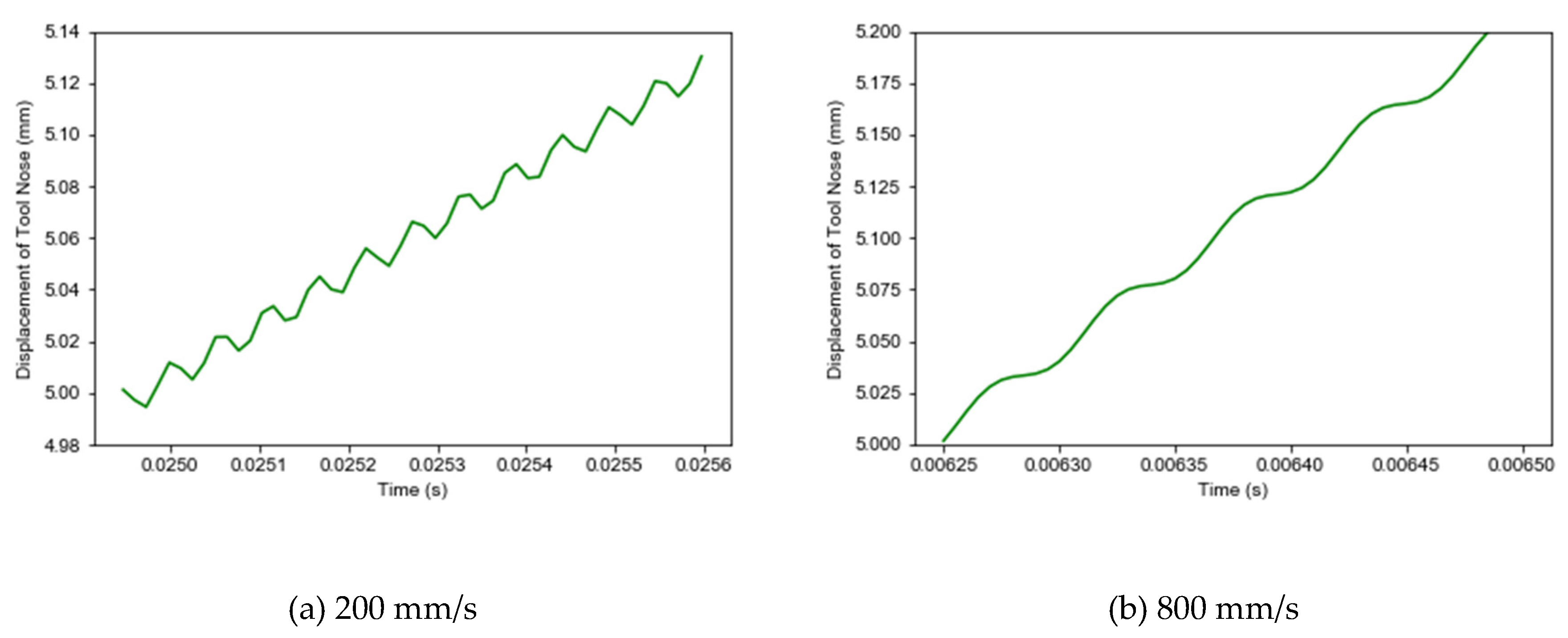
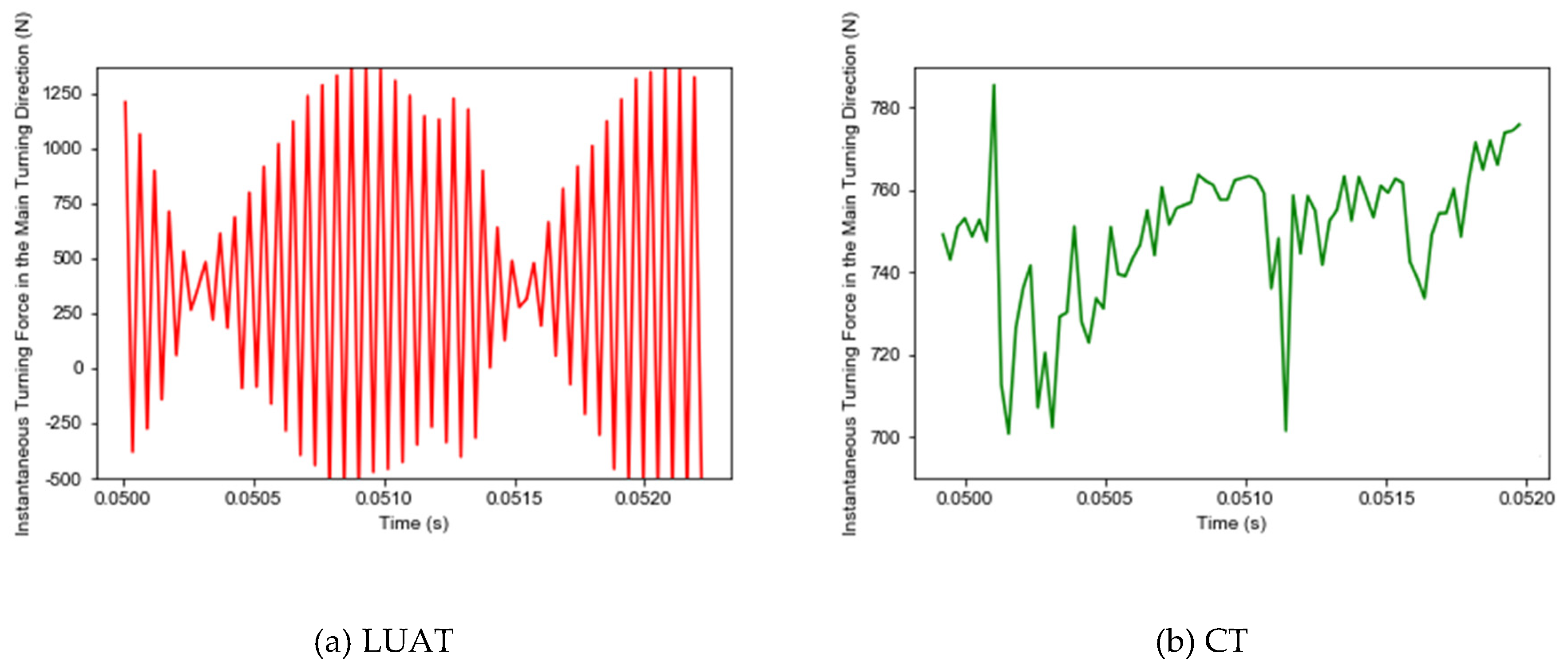

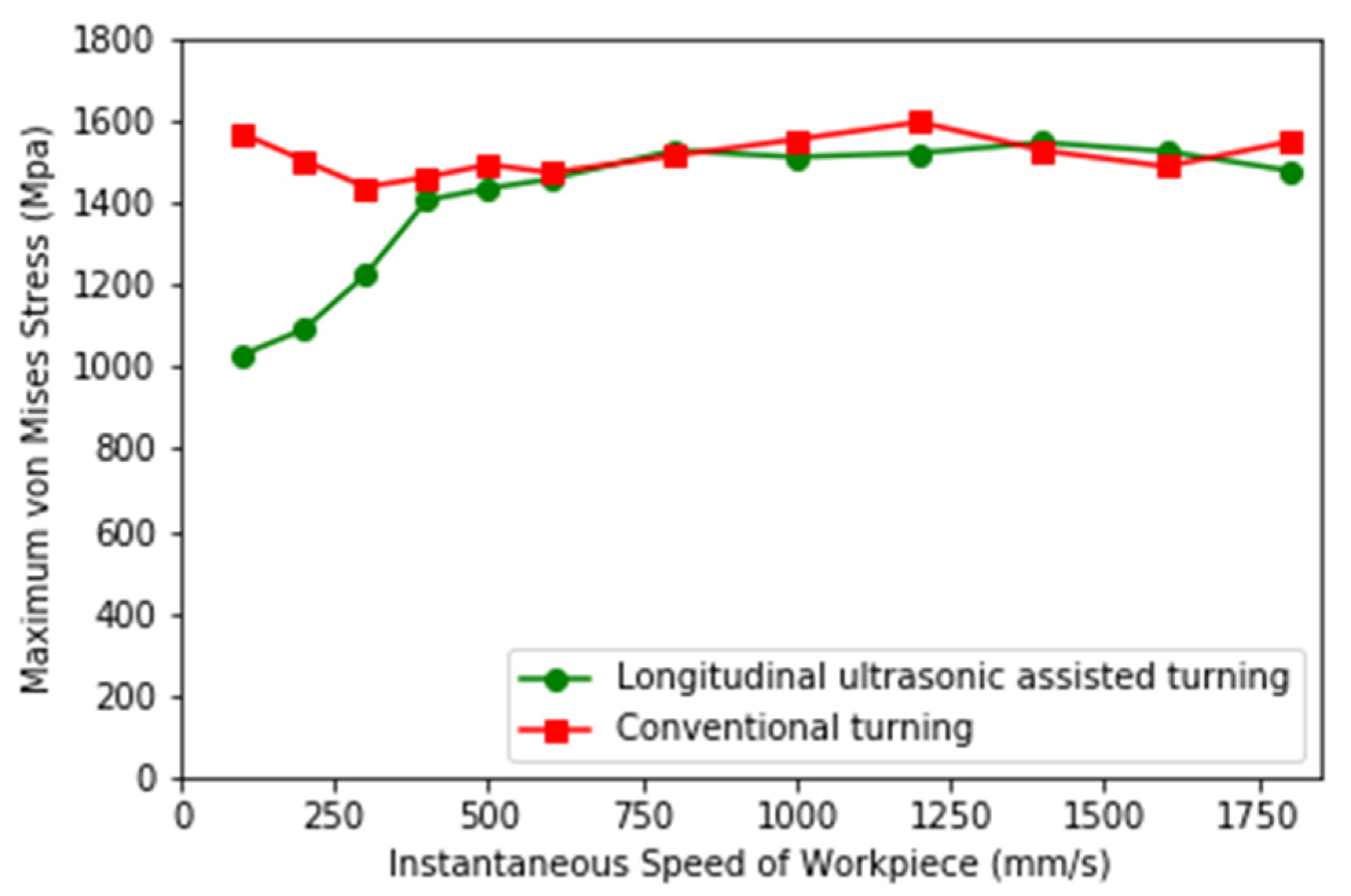

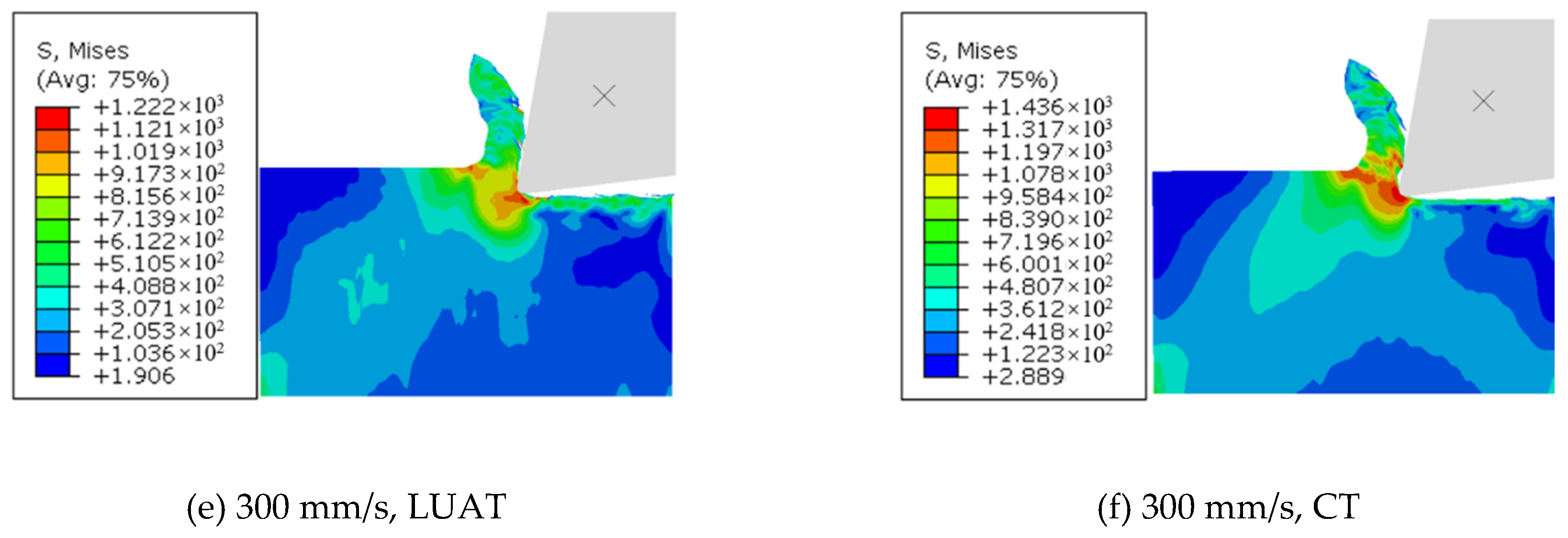

| Material | Poisson’s Ratio (−) | Density (kg/m3) | Young’s Modulus (GPa) |
|---|---|---|---|
| PZT-8 | 0.31 | 7600 | 77 |
| Material | Longitudinal Wave Velocity (mm/s) | Density (kg/m3) | Elastic Modulus (GPa) |
|---|---|---|---|
| 1045 steel | 5.17 × 106 | 7890 | 21 |
| Material | Dilatancy Angle (°) | Friction Angle (°) | Flow–Stress Ratio (−) | Yield Stress (MPa) | Abs Plastic Strain (−) |
|---|---|---|---|---|---|
| Vit1 | 11.902 | 11.902 | 1 | 1194.62 | 0 |
| Material | Poisson’s Ratio (−) | Density (kg/m3) | Young Modulus (GPa) |
|---|---|---|---|
| Vit1 | 0.36 | 6125 | 96,000 |
| YG-8 | 0.22 | 14,700 | 640,000 |
© 2020 by the authors. Licensee MDPI, Basel, Switzerland. This article is an open access article distributed under the terms and conditions of the Creative Commons Attribution (CC BY) license (http://creativecommons.org/licenses/by/4.0/).
Share and Cite
Shan, S.; Feng, P.; Zha, H.; Feng, F. Building of Longitudinal Ultrasonic Assisted Turning System and Its Cutting Simulation Study on Bulk Metallic Glass. Materials 2020, 13, 3131. https://doi.org/10.3390/ma13143131
Shan S, Feng P, Zha H, Feng F. Building of Longitudinal Ultrasonic Assisted Turning System and Its Cutting Simulation Study on Bulk Metallic Glass. Materials. 2020; 13(14):3131. https://doi.org/10.3390/ma13143131
Chicago/Turabian StyleShan, Shuo, Pingfa Feng, Huiting Zha, and Feng Feng. 2020. "Building of Longitudinal Ultrasonic Assisted Turning System and Its Cutting Simulation Study on Bulk Metallic Glass" Materials 13, no. 14: 3131. https://doi.org/10.3390/ma13143131
APA StyleShan, S., Feng, P., Zha, H., & Feng, F. (2020). Building of Longitudinal Ultrasonic Assisted Turning System and Its Cutting Simulation Study on Bulk Metallic Glass. Materials, 13(14), 3131. https://doi.org/10.3390/ma13143131






